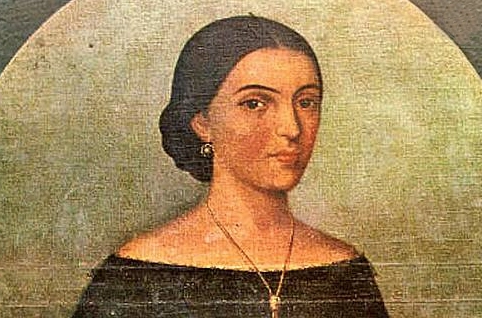In Latin American history, beyond the models of wife and mother, the role of women has traditionally been made invisible or reduced to a sentimental, patriotic, or religious position. Many women, outstanding figures in the history of the region’s Independence, have been forgotten for years, ostracized, or undervalued because of their gender: one of the most emblematic examples is that of Manuela Sáenz.
She is considered one of the protagonists of a kind of female revolution that took place at the beginning of the 19th century, in the midst of the independence revolutions in Latin American territories under the colonial rule of European countries.
Trajectories such as hers demonstrate that the processes of colonial emancipation and national formation harbored innumerable dreams that surpassed the limits established by the Creole elite, that social class that tried, and to a great extent succeeded, in keeping the course of the transformations under its control.
Manuela Sáenz was born in 1797 in Quito. During her childhood she lived the rebellious atmosphere of the movement that in 1809 removed the president of the Royal Audiencia and formed the first “Junta de Gobierno Soberano” (Sovereign Government Board), which was quickly repressed. In 1817, she married, fulfilling an almost inevitable destiny for women of her own affluent social environment. She moved to Lima, where her work with the pro-independence forces earned her the decoration of the order of “Caballereza del Sol” (Knight of the Sun), awarded by San Martín.
Back in Quito in 1822, she participated in the preparations for the Battle of Pichincha and met Simón Bolívar. They shared the dream of integrating the liberated territories into a Confederation of States, Gran Colombia, to face the challenges that the young Latin American nations would face in the context of world geopolitics to maintain their independence and sovereignty.
Upon returning to Peru, she joined the Bolivarian General Staff and became responsible for the archives of the liberation campaign. Here she began his military career: she joined the army as a hussar and in 1824, as a result of the battle of Junín, she reached the rank of “Captain”. In the Battle of Ayacucho, she was elevated to “Colonel”. She promoted the creation of the Republic of Bolivia, which took place in 1825, and it is also possible that she was in that region collaborating directly with the project.
In 1827, she suffered the onslaught of the overthrow of the Bolivarian powers in Peru and was arrested and forced to leave the country. In 1828, she moved to Bogotá, where she was at Bolivar’s side during the period in which he was directly elected president of Colombia. Here, her political influence was felt in several aspects and famous were the episodes in which she discovered and helped to thwart some attempts on the life of the acclaimed Liberator, who was facing opposition groups.
In 1830, even with his resignation and exile, Bolívar remained in the Colombian capital, helping to articulate a new onslaught against power that would bring him back to government. However, this did not happen. Bolivar’s death at the end of that year was one more chapter in the dismantling of the audacious plans to build a “great fatherland”.
The defamatory campaigns and political persecution against Manuela intensified. In 1834, she was exiled and, after spending some time in Jamaica, her attempt to return to Ecuador was also embargoed, so she had to remain in a remote village on the Peruvian coast, where she died in 1856, in the midst of poverty and anguish due to political isolation.
A collective utopia
Her rebellious trajectory – although it did not prevent her from falling, time and again, under the reins of moral repression, sexual objectification, and amorous submission – exemplifies courage and rebelliousness that were collective. Recovering it helps us to make more visible the situation of women from different ethnic and social groups who, by participating in the liberation campaign, challenged the hierarchy of gender relations that limited their experience in both the private and public spheres.
These women creatively instrumentalized the elements that made up the system of their own oppression to act in the struggle and create ways of escape. They were the organizers of the meetings in which conspiracies were articulated; they gave refuge to fugitives; they helped propagate new ideas in their family networks; they acted as spies and messengers, obtaining and transmitting information.
Outside the space of their homes, they participated in protests and collaborated with the press, also making intellectual contributions to the movement. They made material resources available, especially through their labor, to support the liberating armies, as well as accompanying or directly joining the troops when possible. They ran the risk of violent reprisals, such as public humiliation and sexual assault, in addition to the hostility they could face from some of their own fellow soldiers.
It is as if the revolution, by shaking some structures of the old colonial regime, had unleashed forces that were not unprecedented, but had been repressed. The subversion of order, although intended to be limited to the political sphere, inaugurated an exceptional period of life in society and gave rise to the admission and, to a certain extent, encouragement of the suspension of norms in other spheres.
When revolutionary chaos opened the possibility of the imaginary projection of other worlds, women were not simply objects manipulated by the ruling classes. They dreamed not only of liberating their homeland, but also of liberating themselves, constituting to a large extent – together with an over exploited black and indigenous population – the depositary force of the radicalization that sought to transform the political revolution into a social revolution.
With the end of the revolutionary cycle, the new order established under the Creole aegis repressed and expelled not only from the political struggle, but also from historical memory, the revolutions of women and of black and indigenous peoples. Women were pressured to readapt to traditional gender roles, reconverting them into the supportive and appeasing figure of the “mothers of the fatherland,” tailor-made to express love and sacrifice, but not to thematize gender inequalities and discrimination.
Impossible to be portrayed in these terms, Manuela Sáenz initially entered history as one of Bolívar’s most illustrious lovers and for a long time was considered a simple anecdote in the romantic adventures of the Liberator.
In her emancipatory utopia, she expresses the subtle convergence between the projects of national liberation and women’s liberation, pointing out one of the unfinished tasks of the independence processes in Latin America. Therefore, it places us before insurgent movements that mutually constituted each other.
More than 150 years later, the female insurgency that flourished at that time can be considered a pioneer of feminist and Latin American women’s movements, representing a precious legacy that must be retrieved.
Translated from Spanish by Janaína Ruviaro da Silva













